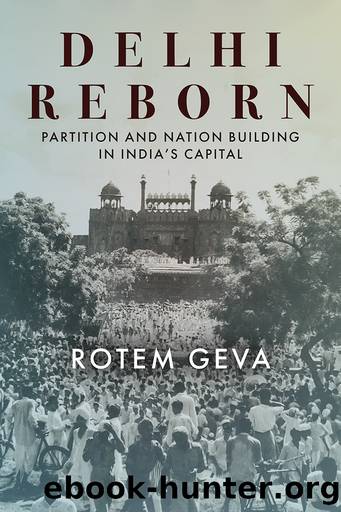Delhi Reborn by Rotem Geva;

Author:Rotem Geva;
Language: eng
Format: epub
Publisher: Stanford University Press
Published: 2022-06-15T00:00:00+00:00
On the whole, the numerous Punjabi proprietors and editors, reporters, columnists, writers, poets, and intellectuals who arrived in Delhi formed a diverse crowd, reflecting the broad ideological spectrum of late-colonial Punjabâfrom communists and progressives to Hindu Mahasabha proponents and Akali Sikhs. We cannot do justice to this heterogeneity, and we concentrate instead on the most important Hindu dailies in Lahore, all of which later shifted to Delhi, and all of which engaged in ferocious exchanges with Muslim publications, simultaneously expressing and intensifying communal polarization.78 By the late 1920s, the three most important Hindu dailies in Lahore were the Arya Samaji Milap and Pratap, and the Sanatan Dharmi Vir Bharat. A contemporary joke that played on the names of Lahoreâs dailies was that the paper that caused the most discord and rift was Milap (Union or Agreement), the most cowardly one was Pratap (Vigor, Courage), and the most conservative one was Inqalab (Revolution, a Muslim paper).79 Daechselâs study of these publications in the 1930sâ1940s finds that they focused on communal tensions and such sensational matter as crime, natural calamities, and accidents, and that conflict and fear were their defining themes.80
Mahashay Krishna launched Pratap in March 1919, in the context of the Gandhian satyagraha against the Rowlatt Act. He named the paper after the sixteenth-century Rajput Hindu ruler, Maharana Pratap Singh, who fought the Mughal Akbar. Along with the semantic range of the word pratapâglowing heat, vigor, glory, ardor, and zealâthe name evokes Hindu masculine heroism. Krishna was a prolific writer who commented on the burning issues of his time, âa kind of firebrand who simply would not bow to anybody.â81 He and Lala Kushal Chand, who established the daily Milap four years later in 1923, may have been professional competitors who criticized each other in pungent editorials, but also close associates who went on long walks every evening.82 Both Krishnaâs and Kushal Chandâs families took an active part in the nationalist struggleâfamily members were imprisonedâand their newspapers published nationalist materials deemed objectionable by the government.83 Their nationalist politics exemplified the politics of Hindus in late-colonial Punjab, where there was an overlap between the Congress and the Hindu Mahasabha in terms of membership and political sentiments.84
When the partition riots broke out in Lahore, Milapâs office was burned down, and its workers barely escaped under army protection, mirroring the fate of Dawn in Delhi. It reopened soon after in Delhi.85 Likewise, Krishna and his family left Lahore and relocated in Delhi, reestablishing Pratap in Panchkuian Road in Paharganj, now a hub of Punjabi presence in the city. Together they became important mouthpieces voicing the concerns and grievances of the cityâs refugee community. The first piece of information on Milapâs relocation is a mention that Kushal Chand was arrested following an âobjectionableâ speech he delivered in a Hindu Sahayata Samiti public meeting.86 In subsequent years, both newspapersâ relations with the Delhi administration remained tense, as their vocal and confrontational writing was critical of the Congress and closely aligned with the Hindu right.
We should note
Download
This site does not store any files on its server. We only index and link to content provided by other sites. Please contact the content providers to delete copyright contents if any and email us, we'll remove relevant links or contents immediately.
| Central Asia | Southeast Asia |
| China | Hong Kong |
| India | Japan |
| Korea | Pakistan |
| Philippines | Russia |
The Rape of Nanking by Iris Chang(3531)
The Sympathizer by Viet Thanh Nguyen(3529)
World without end by Ken Follett(3016)
Ants Among Elephants by Sujatha Gidla(2933)
Blood and Sand by Alex Von Tunzelmann(2615)
Japanese Design by Patricia J. Graham(2567)
City of Djinns: a year in Delhi by William Dalrymple(2140)
Inglorious Empire by Shashi Tharoor(2108)
In Order to Live: A North Korean Girl's Journey to Freedom by Yeonmi Park(2064)
Foreign Devils on the Silk Road: The Search for the Lost Treasures of Central Asia by Peter Hopkirk(2062)
Tokyo by Rob Goss(2025)
India's Ancient Past by R.S. Sharma(1994)
India's biggest cover-up by Dhar Anuj(1992)
The Great Game: On Secret Service in High Asia by Peter Hopkirk(1965)
Tokyo Geek's Guide: Manga, Anime, Gaming, Cosplay, Toys, Idols & More - The Ultimate Guide to Japan's Otaku Culture by Simone Gianni(1953)
Goodbye Madame Butterfly(1942)
The Queen of Nothing by Holly Black(1771)
Living Silence in Burma by Christina Fink(1738)
Batik by Rudolf Smend(1726)
